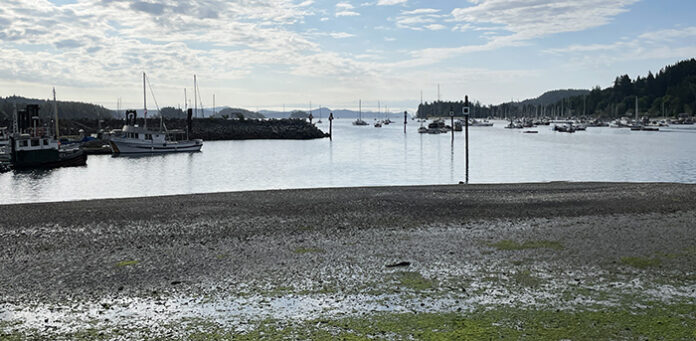As water quality sampling ramps up for the summer swimming season, the health authority has added two new saltwater data points on Salt Spring Island — not at popular swim beaches, but in Ganges Harbour.
Samples from the two new sites — at the Centennial Park bulkhead and Churchill Beach — were tested Wednesday, June 21, for enterococci, the indicator bacteria Island Health uses to identify the presence of fecal contamination and provide an indication of the potential risk associated with swimming in a particular location.
The results put Ganges Harbour well into the “safe for swimming” column — from a microbiological perspective, at least, according to Island Health standards.
Saltwater beaches are generally deemed “safe for swimming” when single sample results, or the average of the most recent five, find fewer than 35 of the bacteria per 100 mL sample, according to Island Health. The health authority will typically issue a red “swimming not recommended” warning at 70 per 100 mL, when there is “significant risk of illness” from entering the water.
Tests at Ganges Harbour showed “LT5” — meaning fewer than 5 of the bacteria found per 100 mL sample — in the water off Centennial Park, and 18 per 100 mL off the end of Churchill Road.
During the same June 21 round of testing at lakes on Salt Spring — for E. coli, the indicator bacteria used for fresh water — St. Mary and Cusheon Lakes showed “LT5” (fewer than 5 bacteria per 100 mL), Blackburn and Stowel (aka Stowe) Lake 5, and Weston Lake 20.
For E. coli, a red warning is typically issued when results exceed 400 counts per 100 mL, or when the most recent five samples show greater than 200. Last August, Island Health temporarily advised against swimming in Stowel Lake as counts there reached 495.
While previous summers have seen Island Health testing samples only from popular freshwater swimming spots on Salt Spring from mid-May to September, the health authority regularly tests samples from saltwater beaches elsewhere within its region. Samples are collected by municipalities and regional districts — in this case, the Capital Regional District (CRD) — then sent for testing and the results analyzed by Island Health.
Salt Spring Island’s CRD senior manager Karla Campbell said the new testing was requested by the group supporting the Clean and Safe Harbours Initiative (CASHI), which advocates regulating liveaboards in Ganges Harbour partly over concerns human waste was being discharged there by people living afloat.
Indicators of fecal material in waterways come from numerous sources, according to Health Canada, commonly from insufficiently-treated wastewater effluent. The Ganges Harbour Wastewater Treatment Plant releases treated and disinfected water from the sewer into the harbour — but through a nearly five-kilometre outfall that discharges well past Second Sister Island, at a depth of some 16 metres below sea level.
The treated wastewater is monitored regularly, and according to reports from the CRD’s Gulf Islands and Port Renfrew Wastewater Facilities Environmental Monitoring Program, the “marine environment surface water” — also called the system’s “receiving water,” in this case at the mouth of Ganges Harbour — is checked every four years, or in the event of an emergency or unscheduled bypass or overflow from the treatment plant.
The last time that water was checked was in 2020, at which time all results were well below regulatory limits. One non-routine/emergency event in 2022 met the criteria to trigger unscheduled sampling, according to CRD reporting, but staff were unable to complete the testing within the required time for the results to be meaningful, “due to staff capacity and weather restrictions.”
The receiving water at the end of the long outfall is next scheduled to be tested in 2024.
To see Island Health’s complete 2022 season sampling results, visit www.islandhealth.ca/sites/default/files/environment/documents/si-beach-sampling-report.pdf.


In the absence of any real popular consent, sometimes consent must be manufactured.
Over these past few months CASHI has had the opportunity to address this forum’s participants and directly engage on an individual to individual basis.
They did only once. Isn’t odd for someone who is seeking public consent to address only one person out of dozens?
Furthermore, this communication miraculously resulted in exactly what CASHI needs: potential consent. From someone who seemed staunchly opposed to the proposal, no less.
Also, this is that person’s first set of postings. That person apparently missed earlier opportunities to speak up.
Why is this so ? Are we being toyed with?
One last question: it seems one of your colleagues post under multiple different names? Why is this? Is this a misconception on my part ?
More to come please follow my posts
And talk to your MP